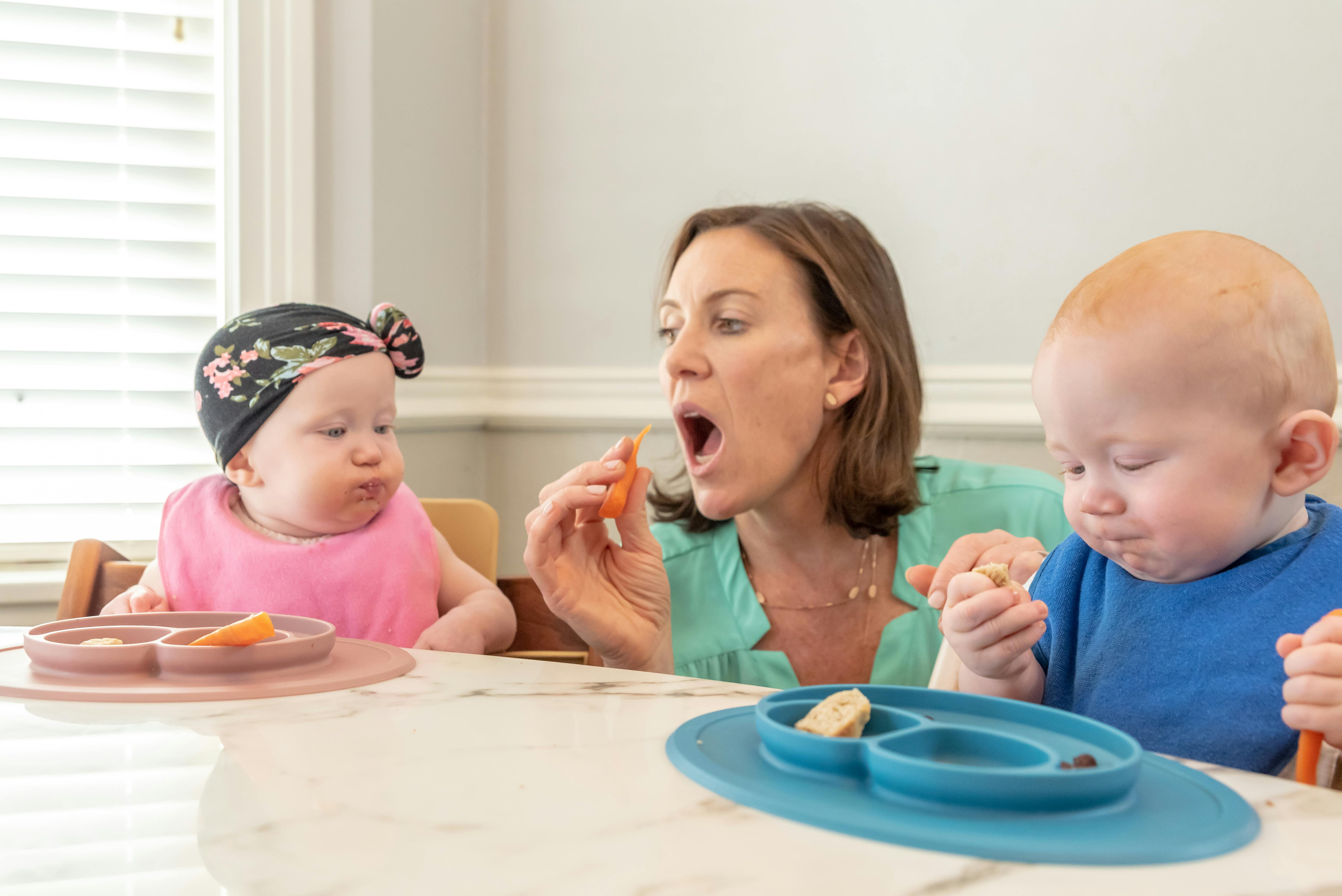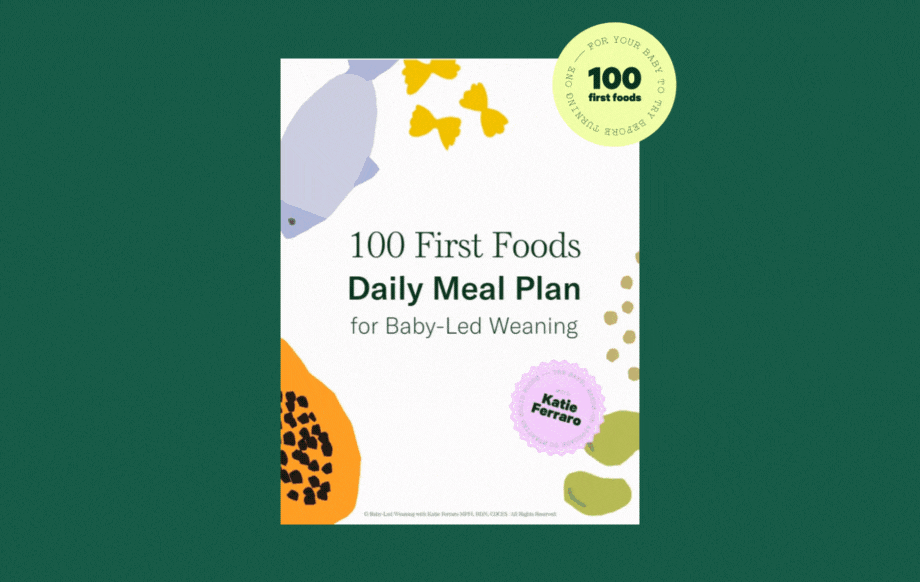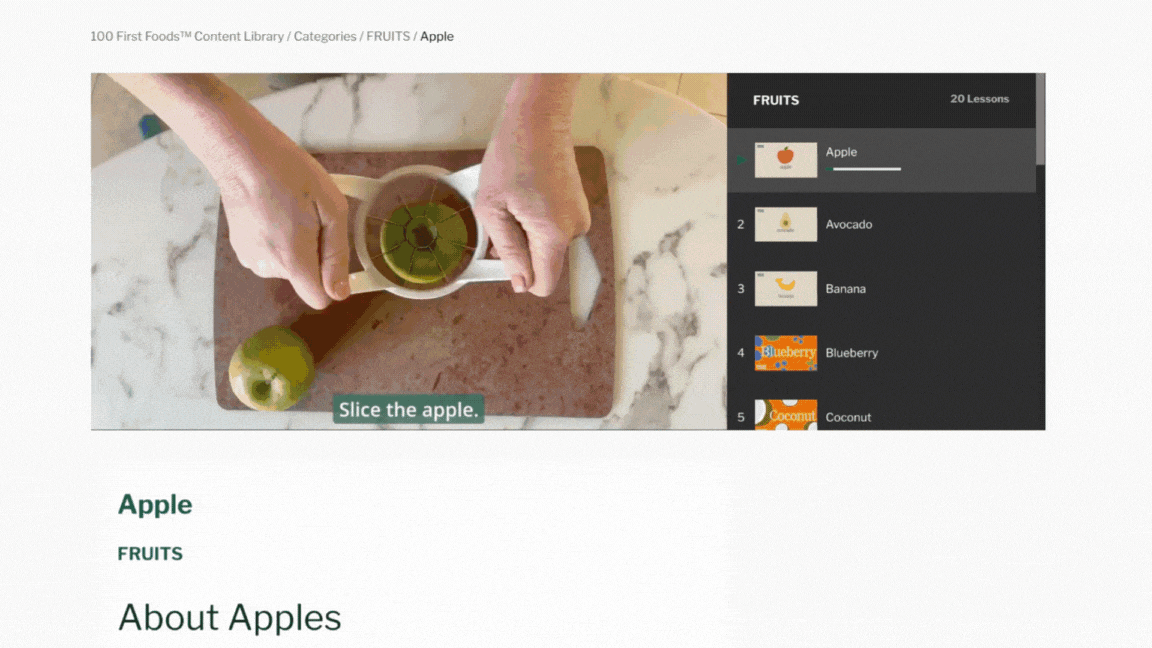Written by Katie Ferraro, MPH, RDN
Disclaimer: The information in this post was written by a dietitian specializing in infant feeding and baby-led weaning. The information in this post is not intended to replace the medical advice of your provider. This is not a sponsored post. This post does contain affiliate links.

Your baby choking on food while learning to eat is a rare but real risk. I recently surveyed my audience, asking for real-life choking stories, and the many responses I received were eye-opening and, at times, harrowing. I’m sharing a few of these stories below, but for context, I’d first briefly address baby-led weaning and choking risks.
Your KNOWLEDGE About Choking Reduces Risk
Parents who want to start solid foods with their baby using baby-led weaning often cite the fear of gagging or choking as their primary barrier.
Published research supports the idea that babies who start solid foods using a baby-led approach to feeding are at no higher risk of choking than are traditionally-weaned, spoon-fed babies.
The caveat with this research, however, regards education. The studies show that parents who are educated about avoiding choking risk foods and unsafe feeding practices and THEN start solids with baby using baby-led weaning are unlikely to have more choking incidents than spoon-fed babies.
The key is education about choking risk, which is the overarching theme of this post.
Knowing what foods to avoid and what feeding practices to avoid are important for ensuring safety in feeding.

What Increases Choking Risk?
The American Academy of Pediatrics (AAP) states that approximately 50% of choking incidences in babies occur from food.
One large choking study analyzed data from more than 12,400 children ages 0-14 who were admitted to the ED for nonfatal food-related choking. Researchers found that most of the foods that cause choking are things like hard candy (15%), other candies (13%), meat other than hot dogs (12%) and bones (12%). Other high-risk foods include things like hot dogs, seeds and nuts, and these are more likely than other foods to cause hospitalization for infant and child choking.
Many non-food items, such as batteries and latex balloon pieces, are also responsible for infant choking.

Real Life Stories of Babies Choking on Food
Recently I asked my audience if they would share any first-hand experiences they have with babies choking on food.
The responses were overwhelming - and in most cases difficult to read. But I appreciate all of the respondents’ openness and honesty as well as their willingness to share their frightening experiences to help others avoid ever having to experience the same.
The point of sharing these stories is not to place judgment on the parents or the feeding practice that caused choking, but rather to serve as an opportunity for educating all of us about how easily choking can occur, and what we can do to prevent it.
The parents and caregivers who told me about their choking experiences have authorized me to retell their stories here.

“We still get sick to our stomach thinking about it…”
One mother shared her story about her then 3-year-old who grabbed and ate a grape at a restaurant before she had a chance to cut anything up.
Mom started the Heimlich but could not dislodge the grape. She asked someone to call 911, and her husband took over. When Dad attempted the abdominal thrusts, he was able to get the grape out, and the toddler threw up in the middle of the restaurant.
“We still get sick to our stomachs thinking about it,” mom shares. Her story shows that while most of us are aware that intact grapes are a choking hazard (one of the biggest hazards, even for older kids), an agile baby or toddler can swipe and choke on a grape in a split second.
If you are serving grapes or cherry tomatoes to a baby, cut them in quarters. Even for toddlers, continue cutting grapes or cherry tomatoes in half, and never let children run around while eating grapes (or any food for that matter) as this greatly increases choking risk.
How old was your baby when you felt safe enough to offer them grapes?!
“He hadn’t made one noise...”
A friend of mine and a fellow dietitian shared that her son, who was about 9 months old, was eating leftover pasta she was serving from a container. Mom didn’t realize there were garbanzo beans at the bottom of the container, and the baby had a silent choke.
Grandma and mom were BOTH sitting at the table with the baby, and they noticed that the baby was turning blue. “He hadn’t made one noise,” mom says. The parents had taken infant CPR and other infant safety courses, but in the moment she says, “I honestly just froze. I started screaming, my husband was home and he ran over, put my son upside down and started hitting him on the back. The food flew out of his mouth.”
Should she not have continued trying to feed her baby solid food after this event?
"So many people told me I was crazy for continuing with baby-led weaning after this, but I know that choking can happen at any age. I felt like I was giving him the tools to learn how to have a healthy relationship with food from a young age. Now he is almost 3.5 and eats anything and everything around him!"
This story demonstrates the importance of knowing what to do in the event of a choking risk. Both parents were familiar with infant CPR, and their knowledge of how to administer back blows likely saved their son's life. Furthermore, the culprit food was an intact garbanzo bean. Foods of this size are the perfect size to block a baby's airway.
When feeding foods like garbanzo beans, kidney beans, black beans, and blueberries, smoosh them with your thumb or fingers to flatten them and then serve them to the baby. These foods are great ways to practice a baby's pincer grasp (which usually develops from ages 9-10 months ON), but I don't love them for early eaters (6-7 months of age) because of the choking risk. There is no urgency or hurry to introduce foods like this if you feel more comfortable waiting.

“I’ve been nervous about using the chair ever since…”
Another new mom, also a dietitian, says she just had one choking incident, but it was terrifying. At the very beginning of doing baby-led weaning with her baby, the baby choked on a strawberry.
“He was able to clear it by himself,” she said, but noted that the choking incident occurred when the baby was in a travel high chair at a family member’s house. The chair was tough to extract the baby from when he was choking, and, “I’ve been nervous about using that chair ever since.”
This story drives home the point about high chair safety. The safest way to feed a baby is in a high chair with a foot rest. The foot rest helps support the baby during feeding and facilitates the muscle control needed to safely swallow food. Avoid dangling feet, and if the baby can’t reach the high chair foot rest yet, construct a makeshift footrest using a cardboard box or other similar support.

When it comes to straps, it may seem counterintuitive but with some chairs it is safer NOT to strap the baby in at first. When you start solids at 6 months of age, the baby isn’t crawling or able to climb out of the high chair. It is more important at this phase to be able to quickly remove the baby from the chair (without straps) in the event of a choke.
Check your high chair to make sure the baby isn’t slumping down. Use props such as rolled up towels or receiving blankets to support the baby early on if needed. If you use the Stokke Tripp Trapp high chair, use the plastic baby set without a 5 point harness at first, and then use straps when the baby is older, more confident at self-feeding and more likely to need the harness straps for restraint.
BABY'S FEET RESTING FLAT ON A SOLID FOOTPLATE HELPS FACILITATE A SAFE SWALLOW
“It was pure instinct…”
Kristy is a mom who tells about her choking incident with a rice cracker when her baby was 8 months old.
Her baby began coughing and turning between red and purple in her face after ingesting the rice cracker.
Mom was watching for a few seconds to see if the baby could recover on her own, waiting to see if perhaps it was just a gag baby could overcome by herself. When the baby continued struggling, dad intervened. He took the baby out of her chair and placed the baby so she was facing the floor with head lower than her body.
“He just slapped her on the back and the food came right out. We hadn’t had any formal training on what to do in the event of a choking incident, but our reaction was pure instinct”, mom says. “We were all a bit shaken at first, but we fret less now that we experienced it and we now know how we are going to react the next time.”
Kristy’s lesson teaches us that foods that appear harmless - like a rice cracker - can actually be a choking risk. Dry crackers and dry meats are particularly problematic because they get “stuck” in the baby's airway.
Whenever possible, add moisture, sauces or dippers to make dry foods like meat or crackers easier to handle for babies. This also helps facilitate more saliva inside of the baby's mouth, which further facilitates safe swallowing.
5 SAUCE RECIPES FOR SAFER SWALLOWING
“How could a food marketed to babies be so dangerous?”
Another mom shared a story about her oldest, who is now 2 years old. When he was 7 months old he choked on a yogurt puff.
As mom correctly points out, “Puffs get really slimy and it easily lodged in his throat.” She went on to say, “I had never taken infant CPR class and I had no clue what to do. My instincts kicked in, I finger swept him but it was too far back to reach, so I turned him over and smacked him on the back repeatedly until it came out.”
“We both cried for a long while, and that’s when I started looking into baby-led weaning. I couldn’t fathom how a food marketed towards babies could be so dangerous.”
Puffs are the perfect size to block a baby’s airway. When starting solid foods it is best to avoid circle-shaped foods (like puffs) and stick to longer, spear or strip-shaped foods (think about the size of a fat french fry).
Many parents start food with puffs, thinking they are safe. Puffs become slimy and can become lodged in baby’s airway. There are much safer foods to start with that do not pose a choking risk, and also that are cheaper than puffs and provide nutrition whereas puffs are essentially white bread + air.
One brand of puffs that I do like for baby-led weaning is the Puffworks Baby peanut and almond puffs. These are great for introducing potentially allergenic foods (peanuts and tree nuts), they’re the perfect size for self-feeding and these puffs are so soft that they dissolve easily and can be used even before your baby has teeth.

You can get 15% off all of the Puffworks baby puffs using the affiliate discount code BABYLED. Click here to shop.
“She started choking just as I walked away…”
Another mom shared her story of 3 separate choking incidents. “My oldest daughter when she was 1 started choking on a french fry at a restaurant. I had gotten up to use the restroom and she started choking just as I walked away.”
Her husband yelled to the mom, she returned, picked the baby up, laid her across the adult’s arm (chest-side down) and gave her two back blows until it came flying out.
“I also had an incident where my son when he was 3 or 4 choked on a piece of hard candy while at a baseball game and I had to give him the Heimlich to get it out.”
This mom runs an in-home daycare and also shared an incident once where one of her 2-year-olds began choking on an oyster cracker. “This was probably the one that scared me the most because it took about 4 sets of back blows to get it out.”
I was curious to learn more about the rules governing in-home daycares, and in a follow-up conversation the mom told me, “For an in-home daycare we are not required to have our employees be CPR certified, unless they are going to be left alone with the children. One person has to be present at all times that is certified.”
These stories illustrate a few points:
- Choking can happen anywhere and on any food, so vigilance and attention from caregivers whenever food is offered is essential.
- Hard candy is a huge choking risk; parents often tune out to this if they are feeding babies since babies don’t eat candy….but that same baby is going to eventually be a toddler, and toddlers LOVE candy. Keep kids away from hard and even certain chewier candies because of choking risk.
- Research whether the people responsible for your caring for your children are CPR certified. Many daycare and school-based settings go above and beyond by requiring all caregivers be certified, and these are your safest options.

It’s a good idea to take an infant refresher CPR course before your baby starts solid foods.
Here is a link to a really good, affordable online CPR course that I take each quarter and you can get an extra $10 off with the affiliate discount code KATIE10 when you register here.

REGISTER FOR ONLINE CPR CODE: KATIE10
“And I swore no food in the car after that…”
One of my friends shared that she has had 2 choking incidences, one with each of her 2 sons.
When her oldest was 18 months old he inhaled a Cheerio in the car seat while crying. “That required a flip and whack on the back to dislodge. But it happened in the car and I swore no food in the car after that.”
As for the second incident, “It was literally last week and I had to give my baby the Heimlich. He choked on goldfish crackers at dinner. It was a legit face color changing silent choke.”
This mom had taken a refresher CPR course a few months after her baby was born. When the goldfish was choking her baby, “I popped him out of the chair, got on one knee and had to do the back blow move twice.”
She goes on to say, “I felt oddly calm through the whole thing…maybe it was because I had practiced and knew what to do. But it’s scary sh*t I tell ya!”
These two stories highlight two important points:
- Don’t feed baby in the car seat or a stroller
- Take a refresher CPR course when your baby starts solid foods
The two photos below are examples of what NOT to do: do not feed baby in a car seat or a stroller. Note the reclining position baby that will increase choking risk:


Thank you again to all of the brave parents and caregivers who shared their stories here. We all learn more from our collective experience and I hope this post contains information that helps you establish a safe feeding environment during infancy (6 months+) and beyond.
REGISTER for my free online video workshop BABY-LED WEANING FOR BEGINNERS and grab your copy of the original 100 FIRST FOODS™ list here: https://babyledweaning.co/baby-led-weaning-for-beginners
Looking for a step-by-step, done-for-you solution that shows you exactly which foods to offer your baby and how to make them safely? JOIN my step-by-step digital program BABY-LED WEANING WITH KATIE FERRARO with the 100 FIRST FOODS™ daily meal plan and recipes here: https://babyledweaning.co/program

My digital program BABY-LED WEANING with Katie Ferraro has an entire 100 FIRST FOODS content library plus 100 FIRST FOODS Daily Meal Plan.

When you join the BABY-LED WEANING with Katie Ferraro program you will receive:
- 5 hours of concise video training…you can complete these lessons in the amount of time that your baby naps this week
- 100 FIRST FOODS content library with 100 FIRST FOODS daily meal plan…no more hunting & pecking around the internet on how to make food safe
- 100 Combination Food Baby-Led Weaning recipes…use these recipes your whole family will love in Phase 2 of my baby-led weaning program

ABOUT THE AUTHOR
Katie Ferraro, MPH, RDN is a registered dietitian, college nutrition professor and mom of 7. She specializes in baby-led weaning and is the creator of the original 100 FIRST FOODS™ program. Katie hosts the top-rated parenting podcast BABY-LED WEANING MADE EASY and runs the baby-led weaning YouTube channel and @babyledweanteam Instagram account. Her BABY-LED WEANING with Katie Ferraro digital program is the go to resource for exactly how to start solid foods safely with baby-led weaning and to help your baby eat 100 safe, baby-led weaning foods before turning one.

REFERENCES
Brown A. (2018). No difference in self-reported frequency of choking between infants introduced to solid foods using a baby-led weaning or traditional spoon-feeding approach. Journal of human nutrition and dietetics : the official journal of the British Dietetic Association, 31(4), 496–504. https://doi.org/10.1111/jhn.12528
Cameron, S. L., Taylor, R. W., & Heath, A. L. (2015). Development and pilot testing of Baby-Led Introduction to SolidS--a version of Baby-Led Weaning modified to address concerns about iron deficiency, growth faltering and choking. BMC pediatrics, 15, 99. https://doi.org/10.1186/s12887-015-0422-8
Cameron, S. L., Taylor, R. W., & Heath, A. L. (2013). Parent-led or baby-led? Associations between complementary feeding practices and health-related behaviours in a survey of New Zealand families. BMJ open, 3(12), e003946. https://doi.org/10.1136/bmjopen-2013-003946
Centers for Disease Control and Prevention (CDC). “Nonfatal choking-related episodes among children--United States, 2001.” MMWR. Morbidity and mortality weekly report vol. 51,42 (2002): 945-8.
Committee on Injury, Violence, and Poison Prevention (2010). Prevention of choking among children. Pediatrics, 125(3), 601–607. https://doi.org/10.1542/peds.2009-2862
de Paiva, Christielly S S et al. “Choking, gagging and complementary feeding methods in the first year of life: a randomized clinical trial.” Jornal de pediatria, S0021-7557(23)00079-7. 30 Jun. 2023, doi:10.1016/j.jped.2023.05.011
Fangupo, L. J., Heath, A. M., Williams, S. M., Erickson Williams, L. W., Morison, B. J., Fleming, E. A., Taylor, B. J., Wheeler, B. J., & Taylor, R. W. (2016). A Baby-Led Approach to Eating Solids and Risk of Choking. Pediatrics, 138(4), e20160772. https://doi.org/10.1542/peds.2016-0772
Harris, C S et al. “Childhood asphyxiation by food. A national analysis and overview.” JAMA vol. 251,17 (1984): 2231-5.
Rimell, F. L., Thome, A., Jr, Stool, S., Reilly, J. S., Rider, G., Stool, D., & Wilson, C. L. (1995). Characteristics of objects that cause choking in children. JAMA, 274(22), 1763–1766.
